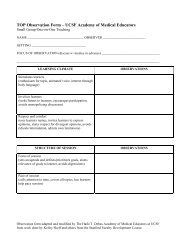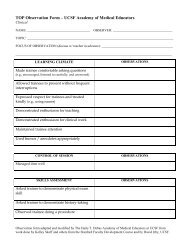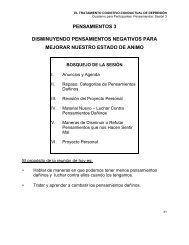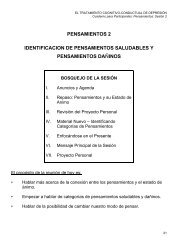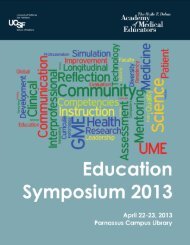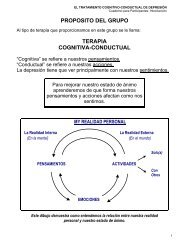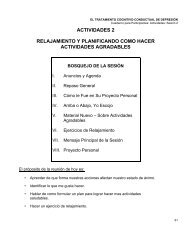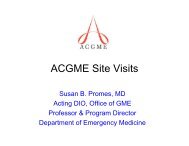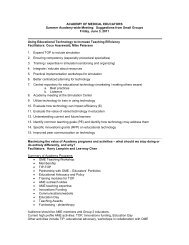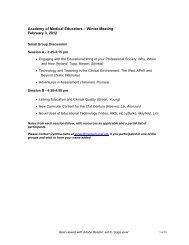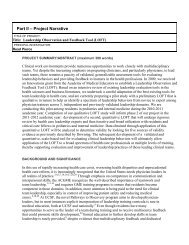2011 - UCSF School of Medicine - University of California, San ...
2011 - UCSF School of Medicine - University of California, San ...
2011 - UCSF School of Medicine - University of California, San ...
Create successful ePaper yourself
Turn your PDF publications into a flip-book with our unique Google optimized e-Paper software.
<strong>UCSF</strong> Education Day <strong>2011</strong>Median examination duration was 1 minute shorter in thehypothesis-driven group (7.0 minutes versus 8.0minutes; p = 0.13).Discussion: In this randomized trial comparing twomethods <strong>of</strong> neurological examination, a hypothesisdrivenapproach resulted in greater sensitivity and atrend towards faster examinations, at the cost <strong>of</strong> lowerspecificity, compared to the traditional screeningapproach. Our findings suggest that while a screeningexamination may be preferable when a focal deficit isunlikely, a hypothesis-driven approach may be superiorwhen the history is concerning for an acute focalneurological process.Reflective critique: We are working with our colleaguesin Emergency <strong>Medicine</strong> to further test this curriculum.A Review <strong>of</strong> Longitudinal MedicalEducational Programs Relating to aPsychiatry Residency ClinicalCurriculum RedesignColin E. Stewart, MD, <strong>UCSF</strong>, Department <strong>of</strong> Psychiatry,Colin.Stewart@ucsf.edu; Danielle Carlin, MD, <strong>UCSF</strong>,Department <strong>of</strong> Psychiatry, Danielle.Carlin@ucsf.edu;John Q. Young, MD, MPP, <strong>UCSF</strong>, Department <strong>of</strong>Psychiatry, JQYoung@lppi.ucsf.edu; Amin Azzam, MD,MA, <strong>UCSF</strong>, Department <strong>of</strong> Psychiatry,Amin.Azzam@ucsf.eduAreas abstract covers: UME, GMEDomain(s) addressed: Clinical Instruction andPerformance, Curricular Innovation, LongitudinalEducational Activities, ResidencyPurpose: We sought to review the literature onlongitudinal educational programs, search for bestpractices and innovations, and relate findings to ourclinical curriculum redesign.Background: <strong>UCSF</strong>’s general adult psychiatryresidency is redesigning its clinical curriculum. Based onour knowledge <strong>of</strong> adult and workplace learning, weintend to include longitudinal educational programs inthe curriculum.Methods: Two authors did independent PubMedliterature searches on longitudinal curricula using MeSHterms from seminal articles in the field. Almost 1,000articles were retrieved. After scanning all titles andreading pertinent abstracts, relevant articles werereviewed. Findings were recorded in a template andcommon themes identified.Results: Factors that significantly impact residentsatisfaction and learning include: 1) Clear goals andobjectives, 2) preceptor and patient care continuity, 3)protection from inpatient responsibilities, and 4)adequate ancillary support. Clinic objectives are <strong>of</strong>tenbased on needs assessments completed via residentsurvey. Other longitudinal experiences such ascommunity projects and problem-based learning (PBL)cases can easily be integrated into clinics to complementlearning in clinical settings. As residents advance, theyneed less direct observation, more guidance in practicemanagement, and more opportunities for self-directedquality improvement projects.Discussion: An ideal longitudinal educational programin a psychiatry residency might involve a weeklyexperience in a general psychiatry continuity clinicspanning all four years that involves lasting relationshipswith preceptors and gradually decreasing direct clinicalsupervision complemented by increasing involvement inpractice management decisions and projects. Anadaptation <strong>of</strong> this abstract was submitted to the WGEA.Reflective critique: A psychiatry residency clinicalcurriculum committee (CCC) comprised <strong>of</strong> educatorsfrom multiple <strong>UCSF</strong> training sites meets regularly toreview findings and discuss their implications for ourcurriculum redesign. Resident feedback is also beinggathered from a pilot continuity clinic at our VA trainingsite and will be reviewed by the CCC prior toimplementing further pilot programs.Anesthesia Journal Clubs: GeneralPractices and Successful FeaturesKathryn Price, MS, <strong>University</strong> <strong>of</strong> <strong>California</strong> <strong>San</strong>Francisco, <strong>School</strong> <strong>of</strong> <strong>Medicine</strong>, kathryn.price@ucsf.edu;Marek Brzezinski, MD PhD, <strong>University</strong> <strong>of</strong> <strong>California</strong> <strong>San</strong>Francisco, Department <strong>of</strong> Anesthesia and PerioperativeCare, BrzezinM@anesthesia.ucsf.edu; H. Nicole Tran,MD, Kaiser Permanente: Oakland Medical Center,,hiennicole@gmail.com; Kathy Schlecht, DO, SouthOakland Anesthesia Associates P.C.,2kschlecht@comcast.net; Annette Mizuguchi, MD PhD,Brigham and Women’s Hospital,AMIZUGUCHI@partners.org; Stephen Kimatian, MD,Cleveland Clinic, kimatis@ccf.org; Guneet Natt, MD,<strong>San</strong> Francisco VA Medical Center,guneet_nat@yahoo.com; John Mitchell, MD, HarvardMedical <strong>School</strong>, Beth Israel Deaconess Medical Center,jdmitche@bidmc.harvard.eduAreas abstract covers: GMEDomain(s) addressed: Evaluation <strong>of</strong> Programs andCurricula, Quality Improvement, ResidencyPurpose: To identify general characteristics <strong>of</strong> journalclub and features associated with higher residentattendance and longevity.26 The Haile T. Debas Academy <strong>of</strong> Medical Educators



